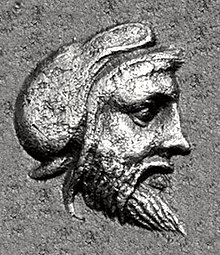| Gongylos | |
|---|---|
 Likely portrait of one of the Gongylid rulers, from a 5th century coin of Pergamon. Likely portrait of one of the Gongylid rulers, from a 5th century coin of Pergamon. | |
| Native name | Γογγύλος |
| Allegiance | Achaemenid Empire |
| Rank | Governor |
| Battles / wars | Second Persian invasion of Greece in 479 BCE |


Gongylos (Ancient Greek: Γογγύλος), from Eretria in Euboea, was a 5th-century BCE Greek statesman who served as an intermediary between the Spartans and Xerxes I of the Achaemenid Empire, and was a supporter of the latter.
After the defeat of the Second Persian invasion of Greece in 479 BCE, Gongylos was forced to flee and take refuge in the Achaemenid Empire. There, Xerxes granted him the territory of Pergamon in Asia Minor from circa 470-460 BCE as a reward. His descendants ruled over the city until at least 400 BCE, forming the Gongylid dynasty of satraps. Gongylos was one of the several Greek aristocrats who took refuge in the Achaemenid Empire following reversals at home, other famous ones being Hippias, Demaratos, and Themistocles. In general, those were generously welcomed by the Achaemenid kings, and received land grants to support them, and ruled over various cities of Asia Minor.
According to Xenophon (Anabasis, 7.8.8-17), when he arrived in Mysia in 399, he met Hellas, the widow of Gongylos and probable daughter of Themistocles, who was living at Pergamon. His two sons, Gorgion and Gongylos the younger, ruled respectively over the cities of Gambrium and Palaegambrium for Gorgion, and Myrina and Grynium for Gongylos. Xenophon received some support from the descendants of Gongylos for his campaign into Asia Minor, as well as from the descendants of Demaratos, a Spartan exile who also had become a satrap for the Achaemenids, in the person of his descendant Prokles.
It is thought that the Greek dynasts of Pergamon were punished following the Peace of Antalcidas in 386 BCE for their support of the Greeks against the Achaemenids. However, by the mid-4th century BCE, the Achaemenid satrap Orontes again allowed the people of Pergamon to settle on the acropolis of their city. This lasted until the conquests of Alexander the Great, when Pergamon became part of the Macedonian Empire.
References
- CNG: MYSIA, Pergamon. Mid 5th century BC. AR Diobol (11mm, 1.72 g, 10h).
- ^ Dreyfus, Renée (1996). Pergamon: The Telephos Friez from the Great Altar; [exhibition, The Metrolopitan Museum of Art, New York, N. Y., 16 January - 14 April 1996...]. University of Texas Press. p. 104. ISBN 9780884010890.
- ^ Miller, Margaret C. (2004). Athens and Persia in the Fifth Century BC: A Study in Cultural Receptivity. Cambridge University Press. p. 98. ISBN 9780521607582.
- ^ Dignas, Beate; Smith, R. R. R. (2012). Historical and Religious Memory in the Ancient World. OUP Oxford. pp. 120–122. ISBN 9780199572069.
- Harvey, David; Wilkins, John (2002). The Rivals of Aristophanes: Studies in Athenian Old Comedy. ISD LLC. pp. 199–201. ISBN 9781910589595.
- Roller, Duane W. (2018). Cleopatra's Daughter: and Other Royal Women of the Augustan Era. Oxford University Press. p. 29. ISBN 9780190618841.
| Rulers in the Achaemenid Empire | ||
|---|---|---|
| Family tree - Achaemenid Kingdom | ||
| Kings of Kings of the Achaemenid Empire |  | |
| Satraps of Lydia | ||
| Satraps of Hellespontine Phrygia | ||
| Satraps of Cappadocia | ||
| Greek Governors of Asia Minor cities | ||
| Dynasts of Lycia | ||
| Dynasts of Caria | ||
| Kings of Macedonia | ||
| Kings of Tyre | ||
| Kings of Sidon |
| |
| Satraps of Armenia | ||
| Satraps of Egypt | ||
| Satraps of Bactria | ||
| Satraps of Media | ||
| Satraps of Cilicia | ||
| Other known satraps | ||
| In most territories, Achaemenid rulers were succeeded by Hellenistic satraps and Hellenistic rulers from around 330 BC | ||